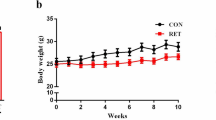Summary
Background. We recently demonstrated that chronic physical exercise increases pancreatic protein content and basal amylase secretion. It is unknown whether chronic exercise causes hypertrophy or proliferation of pancreatic acinar cells.
Methods. Female F344 rats (age, 6 wk) were divided into control (n= 7) and exercise (n=6) groups. Food consumption was matched between the 2 groups. Rats in the control group were kept sedentary. Rats in the exercise group were exercised for 60 min, 5 d/wk during the experiment. After 8 wk, the pancreas and hindlimb muscles were rapidly excised and weighed. Protein and DNA content and enzyme activity in pancreatic tissue were measured. Pancreatic tissues from control and exercised rats were also prepared for transmission electron microscopy.
Results. Inhibition of growth and hypertrophy of hindlimb muscles were exhibited by the exercise group. In the exercise group, pancreatic wet weight, protein content, and amylase and lipase activities, but not DNA content, were significantly higher than those in the control group. Electron micrographs clearly revealed that acinar cells were hypertrophied and zymogen granules were increased in number in exercised rats.
Conclusion. Chronic endurance exercise increases pancreatic weight, protein content and enzyme activity through hypertrophy of acinar cells.
Similar content being viewed by others
References
Konturek SJ, Tasler J, Obtulowicz W. Effect of exercise on gastrointestinal secretions. J Appl Physiol 1973; 34: 324–328.
Zsinka AJN, Frenkl R. Exocrine function of the pancreas in regularly swimming rats. Acta Physiol Hung 1983; 62: 123–129.
Kugino K, Kishino Y. Effect of voluntary exercise on pancreatic function of rats. Nutr Res 1991; 11: 1273–1283.
Minato K. Effect of endurance training on pancreatic enzyme activity in rats. Eur J Appl Physiol 1997; 76: 491–494.
Minato K, Naito H. The effect of endurance training on the pancreatic enzyme activity in aged rats. Jpn J Phys Fitness Sports Med (In Press).
Rauscher E, Neumann U, Schaich E, Bulow S, Wahlefeldt AW. Optimized conditions for determining activity concentrations of α-amylase in selum with 1,4-α-D-4-nitrophenylmalto-hepatasoide as substrate. Clin Chem 1985; 31: 14–19.
Ziegenhorn J, Neumann U, Knitsch KW, Zwez W. Determination of serum lipase. Clin Chem 1979; 25: 1067.
Gornall AG, Bardawill CJ, David MM. Determination of serum proteins by means of the biuret reaction. J Biol Chem 1949; 177: 751.
Labarca C, Paigen K. A simple, rapid, and sensitive DNA assay procedure. Anal Biochem 1980; 102: 344–352.
Mazzeo RS, Horvath SM. Effect of training on weight, food intake, and body composition in aging rats. Am J Clin Nutr 1986; 44: 732–738.
Crews EL III, Fuge KW, Oscai LB, Holloszy JO, Shank RE. Weight, food intake, and body composition: effects of exercise and of protein deficiency. Am J Physiol 1969; 216: 359–363.
Oscai LB, Holloszy JO. Effects of weight changes produced by exercise, food restriction, or overeating on body composition. J Clin Invest 1969; 48: 2124–2128.
Brannon PM. Adaptation of the exocrine pancreas to diet. Ann Rev Nutr 1990; 10: 85–105.
Borrowman JA, Moyston PD. The trophic influence of cholecystokinin on the rat pancreas. J Physiol (Lond) 1974; 238: 73–75.
Petersen H, Solomon T, Grossman MI. Effect of chronic pentagastrin, cholecystokinin and secretin in pancreas of rats. Am J Physiol 1978; 234: E286-E293.
Biederbick A, Elsasser H. Diurnal pattern of rat pancreatic acinar cell replication. Cell Tissue Res 1998; 291: 277–283.
Sullivan SN, Champion M, Christofides ND, Adrian TE, Bloom SR, Binns Smith M, Worobetz L. The gastroin-testinal regulatory peptide changes of long distance running. Phys Sports Med 1984; 12: 77–82.
Ohta M, Ichikawa M, Sazaki N, Okubo K, Miyasaka K, Fujita Y, Matsumoto M, Funakoshi A. Effect of long-term exercise under restricted-feeding on intestinal content of cholecystokinin and on the pancreas in aging rats. Arch Gerontol Geriatr 1994; 18: 43–51.
Smith ML, Hudson DL, Graitzer HM. Exercise training bradycardia: the role of autonomic balance. Med Sci Sports Exerc 1989; 21: 40–44.
Author information
Authors and Affiliations
Corresponding author
Rights and permissions
About this article
Cite this article
Minato, K., Shiroya, Y., Nakae, Y. et al. The effect of chronic exercise on the rat pancreas. International Journal of Pancreatology 27, 151–156 (2000). https://doi.org/10.1385/IJGC:27:2:151
Received:
Revised:
Accepted:
Issue Date:
DOI: https://doi.org/10.1385/IJGC:27:2:151




